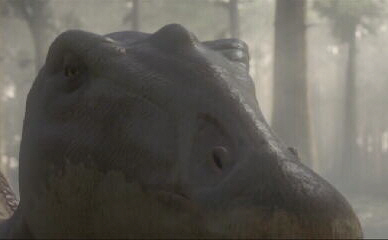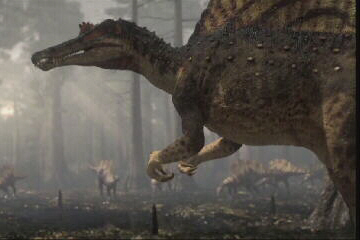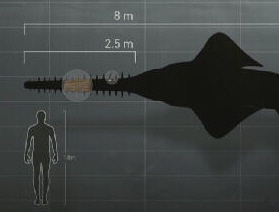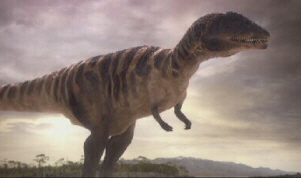Planet Dinosaur – Lost World
The Spinosaurus and Carchadontosaurus
In this programme, we’re exploring the lost world of Africa. For almost a
hundred years this was a forgotten land. Now new discoveries have revealed
some of the most spectacular dinosaurs ever found. Two giant killers
both bigger than T Rex, both living in the same place.
One of these killers, more than any other . has captured the
imagination. A bizarre .killer we’ve only just managed to
reconstruct in the last few years. The story begins in Egypt in
1912 when fragments of a giant dinosaur were discovered. A predator with
2m spines rising above its back. It was unlike anything seen before. It
was only in 2005 when a complete upper jaw was found that we could
accurately reconstruct this bizarre creature. With a skull almost 2
metres long this dinosaur was a colossal 17m long from nose to tail, 4
metres longer than T Rex.

Duck-Billed Ouranisaurus
The reign of the dinosaurs began almost 250 million years ago, but
this killer didn’t appear until a time known as the Mid Cretaceous. 95
million years ago, its home in North Africa was a desert surrounding a
vast system of rivers and swamps.
The swamps are refuges for many large
dinosaurs like the duck-billed ouranisaurus. They’re also the hunting
ground for a killer. At 7m and 3 tons, ouranisaurs are big, but easily
within the scope of a large predator. The spinosaurus, at 17m , the
biggest killer ever to walk the Earth, an 11 ton colossus. Spinosauris
is part of a family of dinosaurs that are relatively newly discovered.
Recent finds have shown that this strange group lived from South America
through Europe to Asia, but the last and biggest of all came from North
Africa.
In 2010, an analysis of their bones and teeth revealed something surprising, chemical traces found in the fossils suggested the
sponosaurus lived more like a crocodile than other land based dinosaurs.
It showed that the dinosaurs spent a large part of their lives in water.
Spinosaurus is a predator, but one that hunts in water. Its a fish
eater.

Spinosaurus
Onchopristis is an 8 metre long giant sawfish, similar to those alive
today. The saw like rostrum is lined with lethal barbs and is itself up
to 2.5 metres in length. Its thought they migrated into freshwater
rivers to breed, where the young may be safer, but the adults are
exposed to new threats. With the breeding season at its height, the
rivers are filled with onchopristis, its the perfect hunting opportunity
for spinosaurus.

Onchopristis
Spinosaurus’ conical teeth evolved to grip prey rather than tear off
flesh, for that it needs powerful arms and claws. With prey plentiful,
spinosaurus can afford to be wasteful. A fact other dinoaurs take full
advantage of.
Spinosaurus is unique, with long narrow jaws and nostrils set high on
its head. Its teeth were straight and conical, they gave us a clue as to
how it killed. More evidence came in 2008 when a spinosaurus skull was
put through a CT scanner. It revealed a cutious pattern of holes and
sinuses in the snout that looked just like those of crocodiles. Its
thought these contained pressure sensors. Sensors that, like a
crocodile, can detect prey maling it perfectly adapted to hunting
in water. This discovery gives us our best evidence of exactly how it
hunted. Able to hold its snout in the water, because of its high
nostrils, it could strike without even seeing its prey.
We can assume so much about the diet of spinosaurus because its
fossilised teeth are commonly found with the remains of the giant
sawfish and more recent discoveries appear to provide even more direct
evidence. In 2005, a spinosaur fossil was found with a sawfish vertebra
stuck in a tooth socket and another discovered in 2008 had a fragment of
a sawfish barb apparently embedded in its jaw, they suggested a clear
predator/prey relationship.
Spinosaurus is the regions biggest killer because it exploit an
environment so successfully. A dinosaur at home in water, for a time it
lived with little threat from other dinosaurs and the species evolved
into a 17m giant.
But, Spinosaurus wasn’t the only giant predator that thrived here.
Carcharodontosaurus, a land-based killer, a meat-eater, a carnosaur. A
cousin of allosaurus, but four times bigger with serrated teeth 16cm
long, carcharodontosaurus was a giant killer. Up to 13 metres long and
weighing 7 tons. Like spinosaurus it too was bigger then T Rex. Big
predators need big hunting ranges. Carcharodontoaurus may have needed up
to 500 square kilometres each, making competition for the best hunting
grounds intense.
The evidence of infighting between carnivores of the same species is
dramatic. Forensic examination of fossils has uncovered injuries on the
skull bones of many large carnivores. Tooth puncture marks and gouges are
remarkable common. Such violent head and face biting is thought, likely, to
be territorial.
With so much to gain, fights over prime hunting territory would be
commonplace. For one victorious carcharodontoaurus the prize is the hunting
right to a herd of ouranisaur. Not an easy prey to catch, even for the
fastest of predators, but we think carcharodontosaurus has a hidden
advantage. In 2008, detailed bone analysis suggested these dinosaurs
employed a system of air-sacs. Air-sacs are used in breathing. they ensure
that oxygen ait flows continually through the lungs when breathing in and
out. Its a very efficient system similar to that of birds. It implied that
dinosaurs, like carcharodontosaurus, were highly active hunters, and they
needed to be. Its reckoned that a dinosaur of this size would need to eat 60
kilos of meat per day simply to survive.

Carcharodontosaurus
Carcharodontoaurus were deadly killers, but not in the way you might expect.
Its skull is relatively weak and computer analysis has shown that they’rs
unlikely to be strong enough to hold onto struggling prey. Their teeth were
thin like knives, too weak to bite through bones, but they were sharp with
deadly serrations, just like a shark’s. The very name carcharodontosaurus
means shark-toothed lizard. We think it used its skull and teeth to
slash deep into the flesh of its prey, causing massive injury and
blood-loss. Delivered at speed, such an attack could kill without the
need for an intense struggle.Its an efficient killing method and one
that’s perfectly suited to this environment.
But, success can look very different when a season changes. For a
time cretaceous North Africa had two deadly killers. By exploiting
different environments thet sisn’t compete and could co-exist,
dominating their chosen habitats. Spinosaurus was a specialist, but this
came with risks. Small environmental changes can make it vulnerable and
this area is prone to seasonal droughts. With the rivers drying,
Spinosaurus’ usual food supply has disappeared, other animals retreat to
a few remaining pools, some the spinosaurus would do well to be wary of.
Smaller crocs re no threat but sarcosuchus a giant 12m crocodile.
Reptiles can survive droughts by, effectively, hibernating during times
of hardship. Spinosaurus can’t. As an active hunter its ,metabolism
demands a regular supply of food. Although it is a specialist, it isn’t
confined to the rivers. In tough times it too can hunt on land.
Spinosaur fossils from other parts of the world have given us more
details about their diets. In 2004 a dramatic fossil was recovered
from Brazil, part of the neck of a pterosaur, embedded in one of the
vertebra was a tooth, the unmistakable shape of a spinosaur tooth. The
stomach contents of another spinosaur was found to contain bones of a
juvenile iguanadon, a plant-eating dinosaur. In spite of their
specialisation, clearly spinosaurs weren’t exclusively fish-eaters.
Hunting on land, Spinosaurus is forced into direct competition with
any large predators living in the same environment and here tat can only
mean one animal; carcharodonosaurus. Contests over carcases are common,
but outcomes of such fights are far from guaranteed. Risk of injury to
big animals is acute. Modern kimodo dragons are often killed in fights
over carcases. More than 3 metres longer, sponosaurus has size and power
on its side, but carcharodontosaurus has the more lethal bite.
In 2008 a spinosaurus vertabra was recovered. Part of the tall neural
spine of the bone was broken off. It appeared to have been bitten in
half. Its been suggested that the bite had been inflicted by
carcharodontosaurus. Spinosaurus was the last and the largest of the
fish-eating dinosaurs, but ultimately these specialists were doomed.
Something way beyond their control caused their downfall. 94 million
years ago, the climate changed. Global sea levels began to rise. The
swamps and rivers that spinosauris thrived in, gradually were lost



